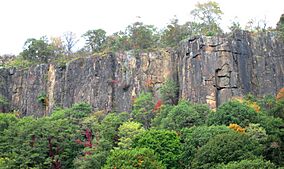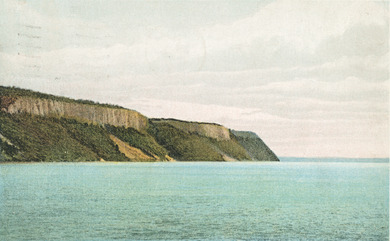The Palisades (Hudson River) facts for kids
Quick facts for kids The Palisades |
|
|---|---|

The cliffs of the Palisades as seen from the Ross Dock Picnic Area in Palisades Interstate Park
|
|
| Location | Northeastern New Jersey (Hudson and Bergen counties) Downstate New York (Rockland County) |
| Designated: | 1983 |

The Palisades are a line of tall, steep cliffs located along the west side of the lower Hudson River. You can find them in Northeastern New Jersey and Southeastern New York in the United States. These impressive cliffs stretch about 20 miles (32 km) north from Jersey City, New Jersey to near Nyack, New York.
The Palisades rise almost straight up from the river's edge. They are about 300 feet (91 meters) high in Weehawken, New Jersey, and gradually get taller, reaching about 540 feet (165 meters) near their northern end. North of Fort Lee, New Jersey, the Palisades are part of Palisades Interstate Park. They are also recognized as a National Natural Landmark, which means they are a very special natural place.
The Palisades are one of the most amazing geologic features near New York City. They help form a canyon along the Hudson River north of the George Washington Bridge. From the top, they offer incredible views of the Manhattan skyline.
The word palisade comes from an old Latin word meaning "stake." A palisade is usually a strong fence made of wooden stakes or tree trunks. The Lenape people, who lived here long ago, called the cliffs "rocks that look like rows of trees." This phrase led to the name "Weehawken," a town in New Jersey located on top of the cliffs.
Contents
How the Palisades Were Formed
The Palisades are made of a type of rock called basalt. These cliffs are the edge of a large rock formation called a sill. It formed about 200 million years ago, at the end of the Triassic period.
This happened when hot, melted rock (called magma) pushed its way up into softer sandstone layers underground. The magma cooled and became solid rock before it reached the surface. Over millions of years, water and weather slowly wore away the softer sandstone. This left behind the harder, column-like rock of the Palisades that we see today. The cliffs are about 300 feet (91 meters) thick in some places. They might have been as tall as 1,000 feet (300 meters) when they first formed.
The formation of the Palisades happened around the same time as a major extinction event 200 million years ago. This event was linked to huge volcanic eruptions that released a lot of lava.
History of the Palisades
The Palisades appeared on one of the first European maps of the New World in 1541. This map was based on descriptions from Giovanni da Verrazzano, who thought the cliffs looked like a "fence of stakes."
Revolutionary War Events
During the early part of the American Revolution, a British general named Lord Cornwallis landed with his soldiers at Huyler's Landing on November 20, 1776. He planned to surprise American General George Washington and end the rebellion. Cornwallis marched his troops up the steep Palisades and south through the Northern Valley.
However, an unknown patriot on horseback warned Washington, who was near Fort Lee. Washington and his troops quickly escaped west, avoiding capture in what is known as Washington's Retreat.
Famous Duels and Early Parks
The Palisades were a popular spot for duels between 1798 and 1845. A duel was a formal fight, often with pistols, to settle disagreements. The most famous duel was between Alexander Hamilton and Aaron Burr. It happened in a spot called the Heights of Weehawken on July 11, 1804.
In 1832, an English visitor named Fanny Trollope wrote about a park created at the Palisades. A ferryboat owner from Hoboken made this park. She described it as a beautiful area with trees and paths along the cliffs, offering amazing views of the Hudson River.
Protecting the Cliffs
After the Civil War, the cliffs were used for advertising. Signs for medicines and other products were painted on the rock face. In the 19th century, the cliffs were also heavily quarried. This meant large amounts of rock were removed to be used for railroad tracks.
People became worried that the Palisades would be destroyed. In the 1890s, groups tried to protect the area. Quarry operators started working even faster, using a lot of dynamite to break down parts of the cliffs.
In 1899, the New Jersey Federation of Women's Clubs helped create the Palisades Interstate Park Commission. This group, led by George Walbridge Perkins, was allowed to buy land along the Palisades to protect it. Their area of protection grew over time.
Creating State Parks
In 1908, New York State planned to move Sing Sing Prison to Bear Mountain. Work began, but conservationists (people who wanted to protect nature) fought against it. They were inspired by the work of the Palisades Interstate Park Commission.
Mary Williamson Averell, whose husband was a railroad president, offered the state 10,000 acres (40 km2) of land and one million dollars to create a state park. George Walbridge Perkins helped raise even more money from wealthy people like John D. Rockefeller and J. P. Morgan. New York State and New Jersey also provided money. Because of these efforts, the prison plan was stopped, and the land became part of the park system.
Modern History and Preservation
In the 1910s, Fort Lee, New Jersey was a center for making movies. The cliffs were often used as filming locations. One famous movie was The Perils of Pauline, a movie series that helped make the term cliffhanger popular.
In October 1931, after four years of building, the George Washington Bridge opened. It connects Upper Manhattan to Fort Lee, crossing over the Hudson River near the Palisades.
In June 1983, the Palisades were named a National Natural Landmark by the National Park Service. This officially recognized their importance as a unique natural feature.
Today, the Palisades are part of Palisades Interstate Park. It's a popular place for hiking and other outdoor activities. The park system also includes other famous parks like Harriman-Bear Mountain State Park.
In 2015, a company called LG Group planned to build a new headquarters in Englewood Cliffs, New Jersey. The original design was very tall and would have been seen above the trees on top of the Palisades. Many environmental groups and politicians were against this. Eventually, LG Group agreed to make the building shorter, so it would not block the natural view of the cliffs.
|
See also
 In Spanish: Palisades (río Hudson) para niños
In Spanish: Palisades (río Hudson) para niños




